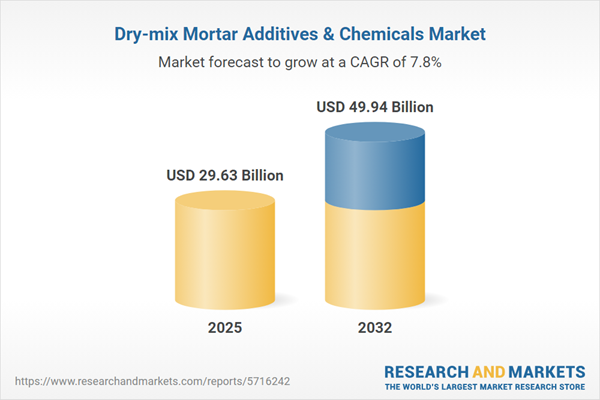Speak directly to the analyst to clarify any post sales queries you may have.
The dry-mix mortar additives and chemicals market is experiencing substantial transformation, driven by evolving construction needs, stringent regulatory landscapes, and technological innovation. Senior decision-makers in construction, manufacturing, and supply chain management must navigate an environment where performance, sustainability, and compliance intersect to define competitive success.
Market Snapshot: Dry-Mix Mortar Additives & Chemicals Market
The Dry-mix Mortar Additives & Chemicals Market grew from USD 27.47 billion in 2024 to USD 29.63 billion in 2025. It is expected to continue growing at a CAGR of 7.75%, reaching USD 49.94 billion by 2032. Leading players are continuously innovating to improve product performance, durability, and regulatory adherence, reflecting the sector’s growing alignment with advanced construction methodologies and global environmental standards.
Scope & Segmentation of the Dry-Mix Mortar Additives & Chemicals Market
- Mortar Types: Grout, Masonry Mortar, Plaster, Render, Self-Leveling Flooring, Tile Adhesive
- Additive Types: Accelerators (Chloride-Based, Non-Chloride), Air-Entraining Agents, Fiber Reinforcements (Glass, Polypropylene, Steel), Plasticizers (Mid-Range, Superplasticizer), Retarders (Natural, Synthetic), Strengtheners, Water Repellents
- End Use Sectors: Commercial, Industrial, Residential
- Form Factors: Liquid Concentrate, Powder
- Application Methods: Automated Mixing System, Mechanical Plastering Machine, Hand Application, Spray Application
- Regions: Americas (United States, Canada, Mexico, Brazil, Argentina, Chile, Colombia, Peru), Europe, Middle East & Africa (United Kingdom, Germany, France, Russia, Italy, Spain, Netherlands, Sweden, Poland, Switzerland, United Arab Emirates, Saudi Arabia, Qatar, Turkey, Israel, South Africa, Nigeria, Egypt, Kenya), Asia-Pacific (China, India, Japan, Australia, South Korea, Indonesia, Thailand, Malaysia, Singapore, Taiwan)
- Leading Companies: Sika AG, MAPEI S.p.A., Saint-Gobain Weber SA, MBCC Group GmbH, Fosroc International Limited, RPM International Inc., ARDEX GmbH, GCP Applied Technologies Inc., Bostik SA, Wacker Chemie AG
Key Takeaways: Strategic Insights for Industry Leaders
- Technological integration, including advanced polymers and nanomaterials, is enhancing workability, adhesion, and long-term durability across diverse construction projects.
- Environmental regulations drive the adoption of low-emission and bio-based additives, aligning industry practices with global sustainability targets and shaping product innovation pipelines.
- Digital platforms are streamlining supply chain transparency, quality assurance, and material traceability, enabling higher operational efficiency and compliance with evolving standards.
- Regional construction trends demand tailored solutions; for example, freeze-thaw resilience in temperate Europe, and moisture management for arid Middle Eastern markets.
- Collaboration with academic partners and startups is vital for new chemistries, enabling companies to stay ahead amid fast-paced regulatory and technical changes.
- Diversified supplier strategies and local production initiatives ensure business continuity in response to shifting trade conditions and geopolitical events.
Tariff Impact: Navigating the United States Tariff Landscape
Recent United States tariff adjustments have increased import duties on raw materials and specialty compounds used in dry-mix mortar additives. Manufacturers are reviewing sourcing strategies, including nearshoring and supplier diversification, to offset higher costs and maintain contractual agreements. The resulting changes in procurement and pricing underscore the need for sustained policy engagement and resilient supply chain management to preserve market competitiveness.
Methodology & Data Sources
This report is based on a rigorous multi-phase approach, including comprehensive secondary research, in-depth expert interviews, and meticulous triangulation between quantitative and qualitative insights. Data integrity is maintained through advanced normalization techniques and industry expert panel reviews, ensuring objective and actionable market intelligence.
Why This Report Matters
- Supports informed strategic planning for product development, regulatory compliance, and technological investment.
- Delivers clarity on region-specific opportunities and risks, equipping stakeholders to enter or expand in high-growth segments.
- Identifies operational best practices and innovation priorities central to building a robust, competitive organization.
Conclusion
The dry-mix mortar additives and chemicals market is advancing through innovation, responsive regulation, and shifting regional needs. This report provides senior executives with the critical insights required to guide resilient, future-ready strategies in a rapidly changing sector.
Additional Product Information:
- Purchase of this report includes 1 year online access with quarterly updates.
- This report can be updated on request. Please contact our Customer Experience team using the Ask a Question widget on our website.
Table of Contents
3. Executive Summary
4. Market Overview
7. Cumulative Impact of Artificial Intelligence 2025
Companies Mentioned
The companies profiled in this Dry-mix Mortar Additives & Chemicals market report include:- Sika AG
- MAPEI S.p.A.
- Saint-Gobain Weber SA
- MBCC Group GmbH
- Fosroc International Limited
- RPM International Inc.
- ARDEX GmbH
- GCP Applied Technologies Inc.
- Bostik SA
- Wacker Chemie AG
Table Information
| Report Attribute | Details |
|---|---|
| No. of Pages | 195 |
| Published | October 2025 |
| Forecast Period | 2025 - 2032 |
| Estimated Market Value ( USD | $ 29.63 Billion |
| Forecasted Market Value ( USD | $ 49.94 Billion |
| Compound Annual Growth Rate | 7.7% |
| Regions Covered | Global |
| No. of Companies Mentioned | 11 |









